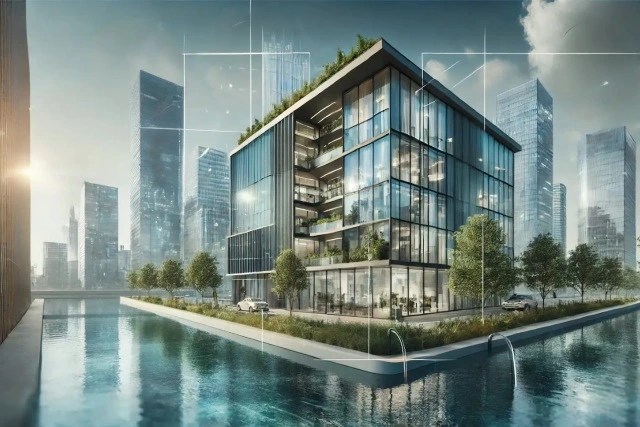As global water stress intensifies due to climate change, population growth, and urbanization, the commercial real estate sector faces mounting pressure to reduce water consumption and improve water management practices. This article dives into current methods of reducing water usage, the regulatory landscape, and water usage reporting.
Advantages of reduced water usage in commercial buildings
Water conservation in commercial buildings isn’t just a trend – it’s a smart business move with far-reaching benefits. From significant cost savings to increased property value, reducing water usage offers advantages that property owners, managers, and investors simply can’t ignore.
Cost control and savings
Here’s how cutting back on water usage can lead to impressive savings:
- Lower water bills: It’s straightforward – use less water, pay less money. Implementing water-efficient fixtures and practices can result in dramatic reductions in the water bills of commercial buildings. 5 story buildings can see a 45% reduction in water consumption by implementing water-efficient fixtures according to a study published at the 5th International Conference on Civil Engineering for Sustainable Development.
- Energy savings bonus: Here’s something many people overlook – saving water also saves energy. Less water usage means less energy for heating, pumping, and treating water. It’s like getting a two-for-one deal on utility savings!
- Reduced sewage charges: Most commercial properties are billed for sewage based on water consumption. By using less water, you’re not just reducing your water bill – you’re also flushing less money down the drain in sewage charges.
- Lower maintenance and repair costs: Water-efficient systems and fixtures often require less upkeep and have longer lifespans than their traditional counterparts. This means fewer repair calls and less frequent replacements, keeping more money in your pocket over time.
- Potential tax incentives: Some jurisdictions offer tax breaks or other financial incentives for buildings that implement water conservation measures. It’s worth checking out – you might get rewarded for doing the right thing.
Importance of water conservation in commercial buildings for investors
Between cost savings and environmental benefits, investors are starting to prioritize water conservation. Properties that showcase a strong commitment to sustainability and efficient resource management are more appealing to potential buyers and tenants. This leads to increased property value and lower vacancy rates.
Sustainability is a top priority for many investors, and water conservation plays a vital role in a property’s overall sustainability profile. Buildings that minimize water waste and boast high water efficiency ratings, such as ESG green buildings or LEED certifications, are particularly attractive to environmentally conscious tenants who value green practices.
Moreover, as sustainability reporting becomes more commonplace in the commercial real estate sector, properties with robust water conservation measures will be well-positioned to meet reporting requirements and showcase their environmental performance to investors and stakeholders.
Reduced water consumption usage in CRE
Reducing water consumption in commercial real estate (CRE) is a multi-faceted approach with various strategies and technologies.
Water-efficient fixtures and appliances
Sometimes, the most significant savings come from the smallest fixtures. Low-flow toilets and urinals have come a long way, now using as little as 1.28 gallons per flush reducing water use by 20% compared to the federal standard of 1.6 gallons per flush toilets, without sacrificing performance. Some urinals even operate without water, saving thousands of gallons annually.
Sensor-activated faucets eliminate the “oops, I left the tap running” problem, typically using 30% less water than conventional faucets. This adds up to substantial savings in high-traffic areas. In buildings with shower facilities, water-saving showerheads can reduce water use by up to 40% without compromising user experience. Some models even incorporate air to maintain pressure while using less water.
Landscaping and outdoor water management
Who says you can’t have a lush, attractive property while saving water? Smart outdoor strategies can help achieve both goals. Native and drought-tolerant species can create beautiful landscapes while requiring minimal watering. It’s like having a low-maintenance, water-sipping garden.
Smart irrigation controllers adjust watering based on weather conditions and soil moisture. According to the EPA, a commercial building complex in Plano, TX lowered its water use for landscaping by 40% with irrigation upgrades. Collecting rainwater for landscape irrigation can significantly reduce reliance on municipal water supplies, like getting free water delivered right to your property.
Leak detection and maintenance
Even small leaks can lead to big losses over time. Staying on top of your building’s water integrity is crucial. Implementing a schedule of routine checks for visible leaks in restrooms, kitchens, and other water-using areas is like giving your building a regular health check-up.
Smart water meters can detect unusual water usage patterns that might indicate leaks. Some can even automatically shut off water flow when leaks are detected, preventing costly water damage. Maintaining optimal water pressure can reduce the stress on pipes and fixtures, preventing leaks before they start.
Water recycling and reuse systems
Why use drinking-quality water for tasks that don’t require it? Innovative ways to reuse water are gaining traction in commercial buildings. Greywater – wastewater generated from sinks, showers, and washing machines – recycling allows water from sinks and showers to be treated and reused for toilet flushing or irrigation. It’s like having a miniature water treatment plant in your building.
Captured rainwater can also be treated and used for toilet flushing or other non-potable applications. In larger properties, treating rainwater and wastewater on-site for reuse in cooling towers or irrigation can lead to substantial water savings.
EU Regulations on Water Usage in Commercial Buildings
The European Union has been at the forefront of environmental legislation, and water usage in commercial buildings is no exception. As part of its broader sustainability goals, the EU has implemented various regulations and directives aimed at reducing water consumption and improving water efficiency in the commercial sector.
Key EU regulations affecting water usage in commercial buildings include:
- The Energy Performance of Buildings Directive (EPBD): While primarily focused on energy efficiency, this directive also addresses water efficiency in buildings, recognizing the interconnected nature of energy and water consumption.
- The EU Water Framework Directive: This overarching water policy aims to ensure good quality water across Europe, indirectly influencing water management practices in commercial buildings.
- Ecodesign and Energy Labelling Regulations: These regulations set standards for water-using products, including those commonly found in commercial buildings, such as cooling systems and water heaters.
- The EU Green Public Procurement (GPP) criteria: While voluntary, these criteria encourage public authorities to purchase goods and services with reduced environmental impacts, including those related to water efficiency.
Reporting on water usage under CSRD
The Corporate Sustainability Reporting Directive (CSRD), adopted by the European Commission in 2021, marks a significant shift in corporate sustainability reporting requirements, including those related to water usage. This directive expands the scope of sustainability reporting and sets more detailed requirements for large companies operating in the EU.
Under the CSRD, many commercial building owners and operators will need to provide comprehensive reports on their water usage and management practices. Here’s what you need to know:
- Scope of reporting: The CSRD requires detailed reporting on environmental factors, including water consumption, water stress, and water management strategies. This goes beyond simple usage metrics to include information on water-related risks and opportunities.
- Data collection and analysis: To comply with CSRD, companies will need robust systems for collecting and analyzing water usage data across their properties. This might include installing smart water meters and implementing water management software.
- Impact assessment: Companies will need to assess and report on the impact of their water usage on local water resources, particularly in water-stressed areas. This could influence decisions about water-saving technologies and water recycling systems.
- Strategy disclosure: The CSRD requires companies to disclose their strategies for improving water efficiency and reducing water-related risks. This could include plans for implementing water-saving fixtures or developing water recycling systems.
- Double materiality: Under the CSRD, companies must consider both how water issues affect their business (financial materiality) and how their water usage impacts the environment and society (environmental and social materiality).
- Audit requirements: The CSRD introduces mandatory audit (assurance) requirements for reported sustainability information, including water-related data. This means companies will need to ensure their water usage reporting is accurate and verifiable.
Regulations for water usage in commercial buildings in the US
Water conservation regulations in the United States operate on multiple levels, with federal, state, and local governments all playing crucial roles. This multi-tiered approach allows for both nationwide standards and region-specific rules that address local water concerns.
Federal regulations
At the federal level, the Environmental Protection Agency (EPA) sets the tone for water conservation through various programs and initiatives:
- WaterSense program: While voluntary, it has become a de facto standard for water-efficient products and practices in commercial buildings.
- Energy Policy Act of 1992: Establishes minimum efficiency standards for water fixtures and appliances.
- Clean Water Act: Influences water usage in commercial buildings through its regulations on wastewater discharge.
- Safe Drinking Water Act: Indirectly affects commercial building water systems through its quality standards for public water supplies.
State and local regulations
State and local regulations often build upon federal standards, adding more stringent requirements based on regional water availability and conservation needs:
- California’s Title 20 and Title 24: Set strict water efficiency standards for commercial buildings.
- New York City’s Local Law 84: Requires large buildings to benchmark their water usage.
- Florida’s Water Star program: Certifies water-efficient commercial buildings.
- International Green Construction Code (IgCC): Adopted by many states and municipalities.
Reporting on water usage with ProptechOS
In the era of smart buildings and data-driven decision-making, ProptechOS can help you accurately report water usage and identify inefficiencies. It acts as the operating system for your building or portfolio to connect disparate systems, software, and sensors in a unified environment. This makes it easy to comply with applicable water usage reporting requirements.
Here are a few of the key features of ProptechOS that make it the ideal solution for reporting on water usage:
- Real-time monitoring: ProptechOS integrates with smart water meters and IoT sensors to provide real-time data on water consumption across your property portfolio.
- Data aggregation: The platform collects and centralizes water usage data from multiple sources, creating a single source of truth for all your properties.
- Customizable dashboards: Users can create tailored dashboards to visualize water consumption patterns, making it easy to spot trends and anomalies at a glance.
- Automated reporting: As an example of ProptechOS’ workflow automation capabilities, it can generate automated reports on water usage. You can tailor each report to meet specific regulatory requirements or internal sustainability goals.
- Benchmarking capabilities: Compare water usage across different properties or against industry standards to identify areas for improvement.
- Predictive analytics: Leverage machine learning algorithms to forecast future water consumption and identify potential issues before they occur.
- Alert system: Set up custom alerts for unusual water usage patterns, potential leaks, or when consumption exceeds predefined thresholds.
Book a demo of ProptechOS for a free guided tour on how ProptechOS can integrate into and optimize your current workflows.

Per Karlberg
Per Karlberg, a distinguished technology executive, demonstrates deep expertise in the nexus of real estate, technology, and ESG. Holding advanced degrees from Lund University, and with key roles as CEO of our company and Co-Founder of ProptechOS, he has shaped the proptech field through significant contributions to real estate technology advancements. His instrumental work in co-authoring “The realestatecore ontology” has facilitated digital transformation and ESG breakthroughs in the real estate sector.
Read his full bio and information here.

